 |
Fort Wayne
Detroit, Michigan, USA
|
|
 |
Constructed: 1843-1851, 1863
Used by: USA
Conflicts in which it participated:
None
|
Anyone with a map can tell that Detroit is very close to Canada. This might not perturb anyone today, but in the 18th and 19th centuries this geographical fact caused a great deal of perturbance...so much so in fact that Fort Wayne is the third fort that Detroit sprouted, a process which began in 1701.
For 'twas in 1701 that the French built Detroit's first fort, creatively named Fort Detroit. The French peered across the (equally creatively named) Detroit river at those threatening British in Canada until the French and Indian War (1754-1763), when they surrendered the fort to the dreaded lobsterbacks in 1760. |
 |
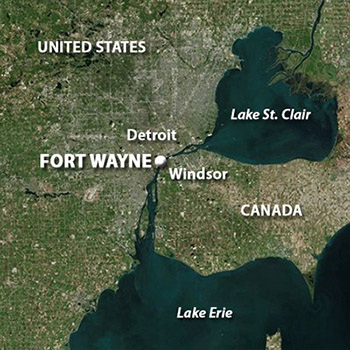 |
|
The British happily occupied Fort Detroit until the garrison's commander, Captain Richard Lernoult, got antsy about a force of American troops that was threatening his position, which he felt was lacking in fortedness. Lernoult began construction of Detroit's second fort on nearby higher ground in November of 1778, and you'll never guess who he named it after! If you've guessed Theodore Roosevelt (1858-1919), you're not playing this game correctly.
Fort Lernoult was completed in October 1779, and 381 British troops were stationed therein. The fort never saw action during the American Revolutionary War (1775-1783), and was one of many fortifications in the US over which the British remained in control at the completion of the war, despite their promise to remove themselves. The Jay Treaty of 1796 caused Fort Lernoult to be officially turned over to the United States: The British relocated across the river at Fort Malden in Amherstburg (not there any more: I looked), and 300 US troops under the command of Lieutenant Colonel John Francis Hamtramck (1756-1803) took possession of the fort. In 1805 US Secretary of War Henry Dearborn (1751-1829) officially changed the fort's name to, of all things, Fort Detroit.
|
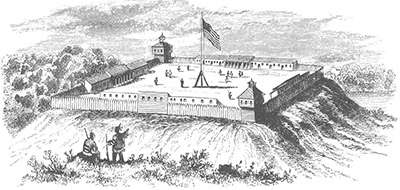 Fort Detroit in 1812. |
 |
Just a month after the War of 1812 (1812-1815) was declared, US Brigidier General William Hull (1753-1825) left Fort Detroit with a force of about 1000 undertrained men, crossed the Detroit River and invaded Canada! This heroic invasion made it all the way to the little Canadian town of Sandwich, which is maybe a mile and a half from where the Americans had embarked. The intrepid invadists occupied Sandwich for about a month until they splashed back across the river to Fort Detroit, with a force of British regulars and Canadian militia hot on their heels.
|
|
|
Attached to the British and Canadians was a force of Shawnee Indians (Native Canadians?), led by Tecumseh (1768-1813). The commander of the British, Major-General Sir Isaac Brock (1769-1812), sent a letter to Hull that suggested an Indian-fueled massacre likely awaited he who did not immediately surrender, which is precisely what Hull did the next morning when the British came across the river, without putting up a whole lot in the way of a fight.
Hull was later court-martialed for surrendering the fort, all its weapons and two unwitting detachments of US troops (one of which was commanded by Lewis Cass (1782-1866), who would go on to be defeated by James K. Polk (1795-1849) in the 1844 US Presidential election) that came marching back into the fort just after it had been given to the British. For some reason, US President James Madison (1751-1836) pardoned Hull, who had been sentenced to be shot for his surrenderage most foul.
Fort Detroit remained in British hands for over a year, until yet another future US President, William Henry Harrison (1773-1841), rode to its rescue with 1000 troops, chasing the British back across the Detroit river. The fort was renamed Fort Shelby in 1813, in honor of Isaac Shelby (1750-1826), who had assisted General Harrison by supplying a regiment of volunteers to the expedition that recaptured the fort.
Fort Shelby was garrisoned for the next 13 years, but apparently not very enthusiastically, because it fell into disrepair. In 1826 Congress gave the fort to the city of Detroit, and it was demolished in the spring of 1827.
Astute readers will at this point realize that the fort to which this page is dedicated hasn't actually appeared yet. You, sir or madam, have a sharp eye and a keen intellect indeed.
|
In the late 1830's, a contingent of American and Canadian citizens, overwhelmed with righteous anger by the British Empire's dominion over Canada, took decisive action. This unrest culminated in series of battles, collectively known as the Patriot War, or the Rebellions of 1837.
Many of the combatants passed through the Detroit area on their way to free Canada. The Federal government was not amused by these doings, however, and as the US was officially neutral on the issue, President Martin Van Buren (1782-1862) felt obliged to send troops to gently prevent these expeditions from launching from US territory.
|
 |
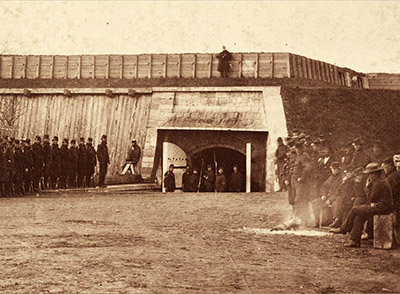 Soldiers of the 1st Michigan laze about Fort Wayne's sally port, 1861 Soldiers of the 1st Michigan laze about Fort Wayne's sally port, 1861 |
|
While attention was being paid to this border, it was realized that the US was sadly lacking in fortifications that might defend the US from British attack, which probably seemed a fairly likely event at the time, as it sure appeared as though the US was sending guerilla troops into British territory to cause trouble.
In 1841, Congress appropriated funds to build a series of forts along the US' northern border, stretching from the Atlantic Ocean to Minnesota Territory: $150,000 was set aside for a new fort at Detroit. The government sent Lieutenant Montgomery C. Meigs (1816-1892) to get things rolling. Meigs bought up riverfront farmland three miles south of Detroit, at the point where Canada was closest, and oversaw the fort's construction there from 1843 to 1851.
The new fort was named for Revolutionary War General "Mad" Anthony Wayne (1745-1796), who had taken possession of Detroit from the British in 1796. Meigs would go on to be the US Army's Quartermaster General during and after the US Civil War (1861-1865), and was a member of the Honor Guard at President Abraham Lincoln (1809-1865)'s funeral.
By the time Fort Wayne was finished, and before any cannon could even be emplaced, Britain and the US had patched up their relationship and there was no longer any need for border defense at Detroit. For a decade after its construction, an unarmed Fort Wayne was garrisoned by a single watchman.
|
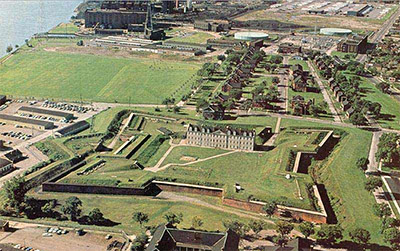
Visible behind Fort Wayne is the extended housing area for the enlarged army camp that sprouted for use during the wars of the 20th century. These houses are now extremely dilapidated. |
 |
Perceived British sympathy for the Confederacy in the US Civil War suddenly brought Fort Wayne back into relevance. The fort served as a center for the mustering of Michigan troops, as well as a convalescent home for wounded US officers. The fort's cedar walls were upgraded to brick and concrete in 1863.
In the decades after the Civil War, Fort Wayne was used as a garrison post, with regiments rotated from the western frontier to rest in a place without arrows being shot at them. During the Spanish-American War (1898), troops collected at the fort headed to Cuba and the Philippines.
|
|
|
Beginning during the First World War (1914-1918), Fort Wayne became the US military's primary supply depot for motorized vehicles and spare parts: Remember, people, Fort Wayne is in Detroit, which, for our non-Norteamericano friends, is the epicenter of the United States' auto industry. Fort Wayne's importance as a vehicular waypoint reached its peak during the Second World War (1939-1945), when over 2000 civilian employees worked at the fort.
The fort housed homeless folks and members of the Civilian Conservation Corps during the Great Depression (1929-1939), and displaced persons following the 12th Street Riots of 1967, during which Detroit tried (unsuccessfully for the most part) to murder itself.
|
Antiaircraft guns, followed by antiaircraft missiles, were installed at Fort Wayne in the 1950's, to defend against the Overwhelming Communist Canadian Air Force (OCCAF). The fort continued to serve as an entrance point to the US Army, and thousands of troops were sworn in at the fort during the Korean War (1950-1953) and Vietnam War (1963-1975).
What was left of Fort Wayne was turned over to the city of Detroit in 1976. Today the fort has a Tuskeegee Airmen Museum, and an "ancient burial mound" (Indians? Vikings?), plus hosts spring and fall flea markets and a variety of festivals.
|
 |
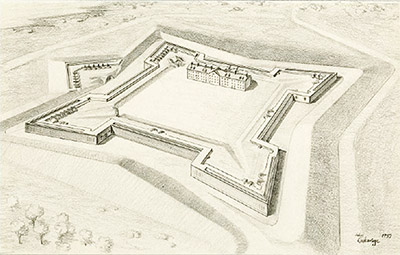 A lovely drawing of Fort Wayne, 1957 A lovely drawing of Fort Wayne, 1957 |
|
What I think is delightfully perverse about Fort Wayne is that, in effect, the only military action it ever saw was before it was built. Perhaps it was so scary that Britain put all its offensive plans on hold the instant it was built, and Fort Wayne proved to be the only thing that prevented Great Britain from completely rolling over the United States in the 1850's. Why, if it weren't for Fort Wayne, we could all be speaking English right now!
|
|
|
|
|
|
 |




